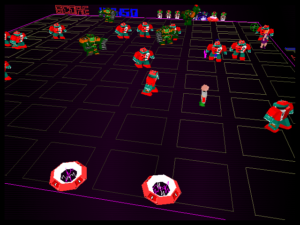Robotron X: Easy Done
Badly in need of distraction yesterday, I turned to Robotron X in earnest. I seemed to hit a wall between levels 30 and 40, though. Things just get a whole lot tougher there. Which is a shame, because that’s also where it starts turning up the variety. Levels 30-39 are the “Electrode Forest”, where the electrodes (stationary deadly obstacles) are shaped like abstracted pine trees and take 30 shots to destroy instead of just one. Levels 30-49 are the “Beam Maze”, where post-shaped electrodes are placed at grid points and periodically fire deadly arcs at their neighbors — something that has less effect than it sounds, because the posts are easily destroyed, so that it all just turns into an empty space from stray fire before long. There are a few other variations along these lines as you progress.
But like I was saying, I was stuck. You can last indefinitely if you’re gaining lives faster than you’re losing them, and I wasn’t doing that. I turned to something like save-scumming — I don’t know if this really fits the definition of that term; I usually think of save-scumming as repeatedly reloading a save until the random number generator provides your preferred outcome, and that’s not what I was doing. Rather, I was reloading my last save every time I died, and saving if I completed a level without dying at all. In this way, I hoped to build up enough lives to survive. But playing this way is laborious, less fun, and, most importantly, violates the spirit of the game. So I finally, reluctantly, turned the difficulty down to Easy.
Easy mode is so much easier than Normal that it almost seems like a different game. No scumming was needed here — the only reason I ever needed to save was to shut down the game for a while and give my fingers a break. I don’t know how many lives I ended the game with, but it was more than the ten that it’s capable of displaying. I feel like I might someday decide that I haven’t really finished the game, that Easy mode doesn’t count because it isn’t the experience that the developers intended. But then, I’m not sure that the experience that the developers intended includes finishing the game. It’s not like the ending is particularly climactic, or wraps up the story or anything. You just play a level like any other, then there’s a rather tongue-in-cheek cutscene, and that’s that.
A few more stray observations and I’ll call it finished:
The last level is actually level 199. There are more than 200 levels, though, because just before every level divisible by 20, there’s a bonus level where you try to shoot at stuff for points but can’t be killed, just like the bonus levels in various spaceship shmups. I speculate that this pattern is the reason we don’t get a level 200. Also, the second hundred are kind of a repeat of the first hundred: just as levels 30-39 are Electrode Forest levels, so are levels 130-139, and so forth. If you get to the midpoint, you’ve basically seen everything. This again makes me think that the devs weren’t designing for completists.
There are no bosses, exactly, but level 3 Brain robotrons are fairly bosslike. They tower over the other robotrons, they take 50 hits to kill, and there are never more than two of them on a level. If that’s a level 3 Brain, what’s a level 4 Brain like? It’s nothing but a huge brain that crawls on the floor like a slug. I appreciate the sense of progression from “humanoid with oversized brain” to “oversized humanoid with even more oversized brain” to “we can’t support the humanoid part any more, here’s just a brain”, but it does make it the one case where a higher-level robotron is less powerful than its predecessor.
I mentioned before that the game spreads out the spawning of enemies, teleporting in new ones over the course of a level to draw things out. I’m fairly sure now that this is linked to progress in shooting stuff, rather than merely timed. There are sections in the Grunt waves where it really seems like it’s spawning new Grunts specifically to replace the ones I’ve killed. Perhaps it’s really a response to technical constraints, rather than being primarily a design decision? This is a game meant to run on 1996 hardware. If you want to throw hundreds of enemies at the player, but can’t render that many 3D robotron models all at once, spawning new ones as you go is the best you can do.
 Comments(4)
Comments(4)